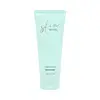What's inside
What's inside
 Key Ingredients
Key Ingredients

 Benefits
Benefits

 Concerns
Concerns

 Ingredients Side-by-side
Ingredients Side-by-side

Water
Skin ConditioningGlycerin
HumectantDimethicone
EmollientOctyldodecanol
EmollientPhenoxyethanol
PreservativePolyacrylamide
Acrylates/C10-30 Alkyl Acrylate Crosspolymer
Emulsion StabilisingC13-14 Isoparaffin
EmollientSilica
AbrasiveCetearyl Olivate
Sorbitan Olivate
EmulsifyingSodium Hydroxide
BufferingPotassium Hydroxide
BufferingDimethicone/Vinyl Dimethicone Crosspolymer
Skin ConditioningLaureth-7
EmulsifyingSalicylic Acid
MaskingEthylhexylglycerin
Skin ConditioningParfum
MaskingDisodium EDTA
Glycyrrhiza Uralensis Root Extract
Skin ConditioningSchisandra Chinensis Fruit Extract
Skin ConditioningPaeonia Lactiflora Root Extract
Skin Conditioning1,2-Hexanediol
Skin ConditioningHippophae Rhamnoides Fruit Extract
Skin ConditioningSalix Alba Bark Extract
AstringentWater, Glycerin, Dimethicone, Octyldodecanol, Phenoxyethanol, Polyacrylamide, Acrylates/C10-30 Alkyl Acrylate Crosspolymer, C13-14 Isoparaffin, Silica, Cetearyl Olivate, Sorbitan Olivate, Sodium Hydroxide, Potassium Hydroxide, Dimethicone/Vinyl Dimethicone Crosspolymer, Laureth-7, Salicylic Acid, Ethylhexylglycerin, Parfum, Disodium EDTA, Glycyrrhiza Uralensis Root Extract, Schisandra Chinensis Fruit Extract, Paeonia Lactiflora Root Extract, 1,2-Hexanediol, Hippophae Rhamnoides Fruit Extract, Salix Alba Bark Extract
Water
Skin ConditioningGlycerin
HumectantButylene Glycol
HumectantGlycereth-26
Humectant1,2-Hexanediol
Skin ConditioningHydroxyacetophenone
AntioxidantAcrylates/C10-30 Alkyl Acrylate Crosspolymer
Emulsion StabilisingPanthenol
Skin ConditioningHydroxyethylpiperazine Ethane Sulfonic Acid
BufferingDiglycerin
HumectantPropylene Glycol
HumectantTriethanolamine
BufferingMethylpropanediol
SolventSodium Hyaluronate
HumectantAllantoin
Skin ConditioningGlucose
HumectantSophora Angustifolia Root Extract
Skin ConditioningStephania Tetrandra Root Extract
Skin ConditioningHydrolyzed Hyaluronic Acid
HumectantCnidium Monnieri Fruit Extract
HumectantGlycyrrhiza Uralensis Root Extract
Skin ConditioningPhellodendron Amurense Bark Extract
Skin ConditioningPhenoxyethanol
PreservativeCaprylic/Capric Triglyceride
MaskingChlorella Vulgaris Extract
Skin ConditioningSpirulina Platensis Extract
Skin ProtectingHydrogenated Lecithin
EmulsifyingChlorphenesin
AntimicrobialHexylene Glycol
EmulsifyingStearic Acid
CleansingCholesterol
EmollientCeramide NP
Skin ConditioningWater, Glycerin, Butylene Glycol, Glycereth-26, 1,2-Hexanediol, Hydroxyacetophenone, Acrylates/C10-30 Alkyl Acrylate Crosspolymer, Panthenol, Hydroxyethylpiperazine Ethane Sulfonic Acid, Diglycerin, Propylene Glycol, Triethanolamine, Methylpropanediol, Sodium Hyaluronate, Allantoin, Glucose, Sophora Angustifolia Root Extract, Stephania Tetrandra Root Extract, Hydrolyzed Hyaluronic Acid, Cnidium Monnieri Fruit Extract, Glycyrrhiza Uralensis Root Extract, Phellodendron Amurense Bark Extract, Phenoxyethanol, Caprylic/Capric Triglyceride, Chlorella Vulgaris Extract, Spirulina Platensis Extract, Hydrogenated Lecithin, Chlorphenesin, Hexylene Glycol, Stearic Acid, Cholesterol, Ceramide NP
 Reviews
Reviews

Ingredients Explained
These ingredients are found in both products.
Ingredients higher up in an ingredient list are typically present in a larger amount.
1,2-Hexanediol is a synthetic liquid and another multi-functional powerhouse.
It is a:
- Humectant, drawing moisture into the skin
- Emollient, helping to soften skin
- Solvent, dispersing and stabilizing formulas
- Preservative booster, enhancing the antimicrobial activity of other preservatives
Acrylates/C10-30 Alkyl Acrylate Crosspolymer is a synthetic polymer. It is used to thicken and improve the texture of products. Due to its properties, it can prevent water and oil ingredients from separating.
Glycerin is already naturally found in your skin. It helps moisturize and protect your skin.
A study from 2016 found glycerin to be more effective as a humectant than AHAs and hyaluronic acid.
As a humectant, it helps the skin stay hydrated by pulling moisture to your skin. The low molecular weight of glycerin allows it to pull moisture into the deeper layers of your skin.
Hydrated skin improves your skin barrier; Your skin barrier helps protect against irritants and bacteria.
Glycerin has also been found to have antimicrobial and antiviral properties. Due to these properties, glycerin is often used in wound and burn treatments.
In cosmetics, glycerin is usually derived from plants such as soybean or palm. However, it can also be sourced from animals, such as tallow or animal fat.
This ingredient is organic, colorless, odorless, and non-toxic.
Glycerin is the name for this ingredient in American English. British English uses Glycerol/Glycerine.
Learn more about GlycerinGlycyrrhiza Uralensis Root Extract comes from Chinese licorice. This plant is native to Asia and used in Chinese traditional medicine. Chinese licorice root contains antioxidants and polysaccharides.
Antioxidants may help with anti-aging by neutralizing free-radical molecules. Polysaccharides help moisturize the skin due to their ability to mimic our natural skin barrier.
Phenoxyethanol is a preservative that has germicide, antimicrobial, and aromatic properties. Studies show that phenoxyethanol can prevent microbial growth. By itself, it has a scent that is similar to that of a rose.
It's often used in formulations along with Caprylyl Glycol to preserve the shelf life of products.
Water. It's the most common cosmetic ingredient of all. You'll usually see it at the top of ingredient lists, meaning that it makes up the largest part of the product.
So why is it so popular? Water most often acts as a solvent - this means that it helps dissolve other ingredients into the formulation.
You'll also recognize water as that liquid we all need to stay alive. If you see this, drink a glass of water. Stay hydrated!
Learn more about Water